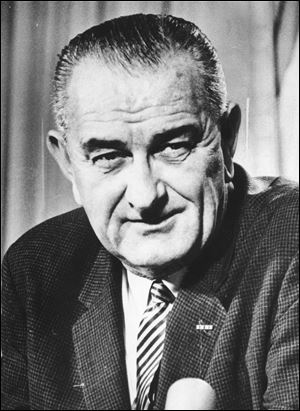
EDITORIAL
Politics and poverty
1/13/2014
Johnson
Government at all levels continues to provide ample examples of waste, fraud, and incompetence. Public-sector efforts to reduce poverty are routinely dismissed as irrelevant, even insidious.
U.S. Sen. Marco Rubio (R., Fla.), in an address that he delivered last week in the LBJ Room on Capitol Hill, urged the nation to reject “big government” as an answer to poverty. Still, on the 50th anniversary of President Lyndon Johnson’s War on Poverty, it’s worth noting that actions by local, state, and federal governments have been at least moderately successful at alleviating poverty.
Structural changes in the U.S. economy have eroded the purchasing power of millions of workers. The federal government must continue to help provide not only a safety net, but also education and training to lift people out of poverty.
Some government anti-poverty programs have been wasteful and ineffective, serving mainly the middle-class bureaucrats who run them. Despite billions of dollars spent to reduce poverty since 1970, poverty rates — now at roughly 16 percent of the U.S. and Ohio populations — have remained stubbornly stable, and even have risen in recent years.
More than 46 million Americans, according to the U.S. Census Bureau, live below the federal poverty line — officially set at $11,500 a year for one person or $23,500 for a family of four. Nearly one in three Americans experienced poverty for at least two months between 2009 and 2011, the Census Bureau reports.
Yet intelligent, accountable government action can work. Direct aid programs such as Head Start and food stamps helped cut poverty rates nearly in half in the 1960s, from 22 percent of Americans to 12 percent, while vastly improving the health of poor children.
Even with a new emphasis on local public-private partnerships, ending poverty in America will take stepped-up efforts by the federal government. That includes raising the federal minimum wage, which continually trails inflation.
Federal and state governments also should allow the working poor to keep more of their money by expanding earned income tax credit programs.
In attacking poverty, Ohio and the rest of the nation face two troubling trends: increases in both extreme poverty and concentrated urban poverty. The poorest city neighborhoods have few jobs, high crime rates, and poorly performing schools.
Overall, large and medium-sized cities such as Los Angeles, Detroit, Miami, Philadelphia, and Toledo report poverty rates of more than 20 percent — often double their states’ rates. With a poverty rate of more than 25 percent, Toledo has one of the nation’s highest rates of concentrated poverty — defined as neighborhoods with poverty rates of 40 percent or higher.
Yet over the past 45 years, the nation’s leaders have paid far less attention to urban poverty, except, briefly, after cities such as Los Angeles exploded into riots. Government alone can’t end U.S. poverty, but the War on Poverty showed that it can alleviate poverty.
Now, federal, state, and local governments, working together, must find new ways to reduce the concentrated poverty that undermines America’s great cities — including Toledo.